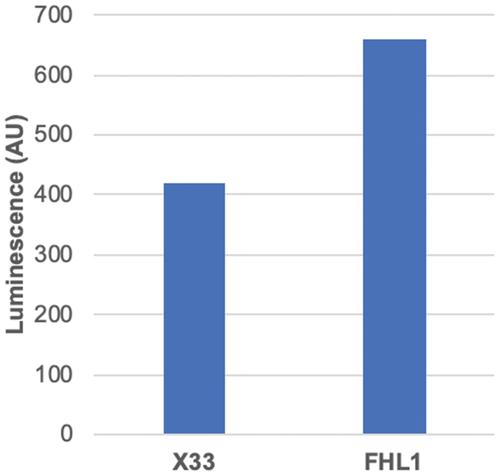Rochelle Aw, Alex J. Spice, Karen M. Polizzi
下载PDF
{"title":"利用毕赤酵母无细胞系统表达重组蛋白的方法","authors":"Rochelle Aw, Alex J. Spice, Karen M. Polizzi","doi":"10.1002/cpps.115","DOIUrl":null,"url":null,"abstract":"<p>Cell-free protein synthesis is a powerful tool for engineering biology and has been utilized in many diverse applications, from biosensing and protein prototyping to biomanufacturing and the design of metabolic pathways. By exploiting host cellular machinery decoupled from cellular growth, proteins can be produced in vitro both on demand and rapidly. Eukaryotic cell-free platforms are often neglected due to perceived complexity and low yields relative to their prokaryotic counterparts, despite providing a number of advantageous properties. The yeast <i>Pichia pastoris</i> (also known as <i>Komagataella phaffii</i>) is a particularly attractive eukaryotic host from which to generate cell-free extracts, due to its ability to grow to high cell densities with high volumetric productivity, genetic tractability for strain engineering, and ability to perform post-translational modifications. Here, we describe methods for conducting cell-free protein synthesis using <i>P. pastoris</i> as the host, from preparing the cell lysates to protocols for both coupled and linked transcription-translation reactions. By providing these methodologies, we hope to encourage the adoption of the platform by new and experienced users alike. © 2020 The Authors.</p><p><b>Basic Protocol 1</b>: Preparation of <i>Pichia pastoris</i> cell lysate</p><p><b>Basic Protocol 2</b>: Coupled in vitro transcription and translation</p><p><b>Basic Protocol 3</b>: Determining luciferase production from cell-free protein synthesis reactions</p><p><b>Alternate Protocol 1</b>: Linked in vitro transcription and translation</p><p><b>Alternate Protocol 2</b>: Quantifying HSA protein concentration</p><p><b>Support Protocol 1</b>: Preparation of mRNA by in vitro transcription for linked transcription and translation</p>","PeriodicalId":10866,"journal":{"name":"Current Protocols in Protein Science","volume":"102 1","pages":""},"PeriodicalIF":0.0000,"publicationDate":"2020-10-27","publicationTypes":"Journal Article","fieldsOfStudy":null,"isOpenAccess":false,"openAccessPdf":"https://sci-hub-pdf.com/10.1002/cpps.115","citationCount":"7","resultStr":"{\"title\":\"Methods for Expression of Recombinant Proteins Using a Pichia pastoris Cell-Free System\",\"authors\":\"Rochelle Aw, Alex J. Spice, Karen M. Polizzi\",\"doi\":\"10.1002/cpps.115\",\"DOIUrl\":null,\"url\":null,\"abstract\":\"<p>Cell-free protein synthesis is a powerful tool for engineering biology and has been utilized in many diverse applications, from biosensing and protein prototyping to biomanufacturing and the design of metabolic pathways. By exploiting host cellular machinery decoupled from cellular growth, proteins can be produced in vitro both on demand and rapidly. Eukaryotic cell-free platforms are often neglected due to perceived complexity and low yields relative to their prokaryotic counterparts, despite providing a number of advantageous properties. The yeast <i>Pichia pastoris</i> (also known as <i>Komagataella phaffii</i>) is a particularly attractive eukaryotic host from which to generate cell-free extracts, due to its ability to grow to high cell densities with high volumetric productivity, genetic tractability for strain engineering, and ability to perform post-translational modifications. Here, we describe methods for conducting cell-free protein synthesis using <i>P. pastoris</i> as the host, from preparing the cell lysates to protocols for both coupled and linked transcription-translation reactions. By providing these methodologies, we hope to encourage the adoption of the platform by new and experienced users alike. © 2020 The Authors.</p><p><b>Basic Protocol 1</b>: Preparation of <i>Pichia pastoris</i> cell lysate</p><p><b>Basic Protocol 2</b>: Coupled in vitro transcription and translation</p><p><b>Basic Protocol 3</b>: Determining luciferase production from cell-free protein synthesis reactions</p><p><b>Alternate Protocol 1</b>: Linked in vitro transcription and translation</p><p><b>Alternate Protocol 2</b>: Quantifying HSA protein concentration</p><p><b>Support Protocol 1</b>: Preparation of mRNA by in vitro transcription for linked transcription and translation</p>\",\"PeriodicalId\":10866,\"journal\":{\"name\":\"Current Protocols in Protein Science\",\"volume\":\"102 1\",\"pages\":\"\"},\"PeriodicalIF\":0.0000,\"publicationDate\":\"2020-10-27\",\"publicationTypes\":\"Journal Article\",\"fieldsOfStudy\":null,\"isOpenAccess\":false,\"openAccessPdf\":\"https://sci-hub-pdf.com/10.1002/cpps.115\",\"citationCount\":\"7\",\"resultStr\":null,\"platform\":\"Semanticscholar\",\"paperid\":null,\"PeriodicalName\":\"Current Protocols in Protein Science\",\"FirstCategoryId\":\"1085\",\"ListUrlMain\":\"https://onlinelibrary.wiley.com/doi/10.1002/cpps.115\",\"RegionNum\":0,\"RegionCategory\":null,\"ArticlePicture\":[],\"TitleCN\":null,\"AbstractTextCN\":null,\"PMCID\":null,\"EPubDate\":\"\",\"PubModel\":\"\",\"JCR\":\"Q1\",\"JCRName\":\"Biochemistry, Genetics and Molecular Biology\",\"Score\":null,\"Total\":0}","platform":"Semanticscholar","paperid":null,"PeriodicalName":"Current Protocols in Protein Science","FirstCategoryId":"1085","ListUrlMain":"https://onlinelibrary.wiley.com/doi/10.1002/cpps.115","RegionNum":0,"RegionCategory":null,"ArticlePicture":[],"TitleCN":null,"AbstractTextCN":null,"PMCID":null,"EPubDate":"","PubModel":"","JCR":"Q1","JCRName":"Biochemistry, Genetics and Molecular Biology","Score":null,"Total":0}
引用次数: 7
引用
批量引用
Methods for Expression of Recombinant Proteins Using a Pichia pastoris Cell-Free System
Cell-free protein synthesis is a powerful tool for engineering biology and has been utilized in many diverse applications, from biosensing and protein prototyping to biomanufacturing and the design of metabolic pathways. By exploiting host cellular machinery decoupled from cellular growth, proteins can be produced in vitro both on demand and rapidly. Eukaryotic cell-free platforms are often neglected due to perceived complexity and low yields relative to their prokaryotic counterparts, despite providing a number of advantageous properties. The yeast Pichia pastoris (also known as Komagataella phaffii ) is a particularly attractive eukaryotic host from which to generate cell-free extracts, due to its ability to grow to high cell densities with high volumetric productivity, genetic tractability for strain engineering, and ability to perform post-translational modifications. Here, we describe methods for conducting cell-free protein synthesis using P. pastoris as the host, from preparing the cell lysates to protocols for both coupled and linked transcription-translation reactions. By providing these methodologies, we hope to encourage the adoption of the platform by new and experienced users alike. © 2020 The Authors.
Basic Protocol 1 : Preparation of Pichia pastoris cell lysate
Basic Protocol 2 : Coupled in vitro transcription and translation
Basic Protocol 3 : Determining luciferase production from cell-free protein synthesis reactions
Alternate Protocol 1 : Linked in vitro transcription and translation
Alternate Protocol 2 : Quantifying HSA protein concentration
Support Protocol 1 : Preparation of mRNA by in vitro transcription for linked transcription and translation


 求助内容:
求助内容: 应助结果提醒方式:
应助结果提醒方式:


